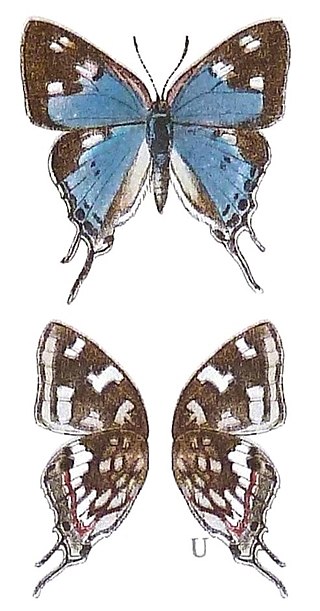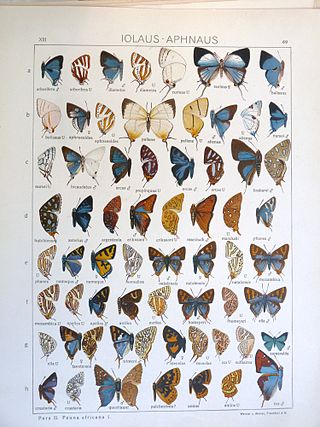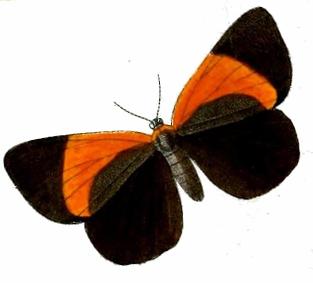
Elymnias hypermnestra, the common palmfly, is a species of satyrine butterfly found in South and Southeast Asia.

Azanus ubaldus, the bright babul blue, desert babul blue, or velvet-spotted blue, is a small butterfly found in India, the Middle East and Africa that belongs to the lycaenids or blues family.

The Azelinini are a tribe of geometer moths in the subfamily Ennominae, with many species in the Southern Hemisphere, particularly in South America. Several species are found in North America as well. These stocky geometer moths seem to be closely related to other robust tribes, such as the Campaeini, Ennomini, Lithinini and Nacophorini – all of which might warrant to be subsumed in the Ennomini – the genus Odontopera, and perhaps the Caberini and Colotoini. The tribe was first described by William Trowbridge Merrifield Forbes in 1948.

Cabera is a genus of moths in the family Geometridae described by Georg Friedrich Treitschke in 1825.

Colotis euippe is a butterfly of the family Pieridae that is found in the Afrotropical realm.
Stygionympha robertsoni, or Robertson's brown, is a butterfly of the family Nymphalidae. It is found in South Africa, in Northern Cape, the southern part of Free State, the northern part of Western Cape and the Eastern Cape.

Colotis regina, the queen purple tip, regal purple tip, or large violet tip, is a butterfly of the family Pieridae. It is found in the Afrotropical realm.

Stugeta subinfuscata, the dusky sapphire, is a butterfly of the family Lycaenidae. It is found in southern Africa.

Cigaritis phanes, the silvery bar, is a butterfly of the family Lycaenidae. It is found in south-west Africa, including Botswana, Zimbabwe and South Africa. In South Africa it is found from north-western KwaZulu-Natal to the northern part of the Free State, Gauteng, Mpumalanga, Limpopo, North West and Northern Cape.

Argyraspodes is a butterfly genus in the family Lycaenidae. It is monotypic containing only the species Argyraspodes argyraspis, the warrior silver-spotted copper, which is found in South Africa, in the Western and Eastern Cape, Free State and Northern Cape.

Tuxentius melaena, the black pie or dark pied Pierrot, is a butterfly of the family Lycaenidae. It is found in Africa.

Chiasmia separata is a moth in the family Geometridae first described by Herbert Druce in 1882. It is found on Saint Helena and has also been recorded from South Africa, Angola, Cameroon, Ivory Coast, Kenya, Madagascar, Mozambique, Nigeria, Rwanda, Tanzania and Uganda.

Acraea lualabae is a butterfly in the family Nymphalidae. It is found in the Democratic Republic of the Congo (Shaba).
Lepidochrysops yvonnae is a butterfly in the family Lycaenidae. It is found in Zambia. The habitat consists of open marshland in wooded grassland.
Macrosoma hedylaria is moth-like butterfly described by William Warren in 1894. It belongs to the family Hedylidae. Originally it belonged to the genus Phellinodes. Malcolm J. Scoble combined it with Macrosoma in 1986.
Diargyria argyhorion is a species of butterfly belonging to the family Noctuidae. It is found in the Eastern and Western Cape, and KwaZulu-Natal Drakensberg in South Africa.
Cabera subalba is a species of geometrid moth, found on the islands of São Tomé and Príncipe in West Africa. It belongs to the monophylectic Cabera subalba Group.
Cabera limbata is a species of geometrid moths, found in Guinea, Ghana, Ivory Coast, and Cameroon in West Africa. It belongs to the monophyletic Cabera subalba group.
Cabera toulgoeti is a species of geometrid moth, endemic to the Pennel area of Moramanga district of Analamazaotra Forest in Madagascar. It belongs to the monophylectic Cabera subalba Group.
Cabera humbloti is a species of geometrid moth, endemic to the Comoros archipelago, specifically the Grand Comoro. It belongs to the monophylectic Cabera subalba Group.










